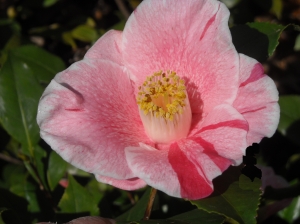How a Gang of Eight Captured our Hearts and Led us Down a New Path
We saw our first camellias many years ago. The Virginia Camellia Society was holding a show and sale at the Norfolk Botanical Garden, home to one of the premier camellia collections in the country.

C. japonica ‘Berenice Boddy’ shines, opening in rough weather and holding fast. Usually pink, this is an older bloom that has paled
Hundreds of perfect blooms were displayed on long rows of tables. Some looked like peonies or roses or anemones.
Some were sweet and unpretentious with a circle of single petals. Some flaunted their good looks, tastefully–formal doubles they were called– or boldly, seducing us with come-hither ruffles.
And how could we resist the colors? Bold reds, pure whites, candy pinks.
For starters, there were Camellia japonicas with handsome shiny leaves that would bloom late winter to early spring and Camellia sasanquas, with smaller leaves, that would bloom from fall into winter. Along with other species and hybrids, we could have bloom for six months of the year.

‘Showa No Sakae,’ dependable and profuse, one of our favorite sasanquas, survives despite being waterlogged during rainy spells
We were like kids let loose in a carnival with cotton candy and caramel popcorn teasing us in tandem. How could we choose? We came for one. We left with eight.
Growing this Gang of Eight was a grand ride that would take us through storms and drought, quirky winters and hot summers.
After thirty years, some of our camellias have grown into trees, and new ones are still toddlers
The Gang became the nucleus of our early camellia efforts. Since then we have combed nurseries and read publications from the American Camellia Society. Fickle gardeners that we are, we have been smitten by one variety after another.

C. japonica ‘Lady Clare,’ an old and sturdy variety with a classic simple flower and bright stamens. We purchased this long ago and it has survived three transplantings, muddy soil and misguided pruning
Almost immediately we learned how to propagate them, and kind gardeners willingly invited us in to air layer their favorite camellias.
As we took this journey and learned to care for our camellias and made mistakes and kept experimenting, we have lately realized we have become experts on our own plot of land.
We’ve come to know its soils and drainage. We learned where the sun shines brightest and hottest and where tree leaves dapple its light.
We feel the wind on our backs and we know we should take care where we plant. We know intimately the niches of our garden and how snug they are.
Camellias have become the bones of our garden. Today we grow almost 100 of them. The garden has changed in thirty years, but our optimism for what’s around the corner has not. Nor have the delights of discovering the first camellia blooms of the season ever become jaded.

You can’t create long-stemmed bouquets with camellia blossoms but floating blooms in a bowl of water can make a lovely centerpiece
Camellias in our Garden Siting and Planting Camellias
Pruning and Fertilizing our Camellias Insects and Diseases of Camellias
Camellias Become Collateral Storm Damage Camellia Recovery and Care
Air Layering Camellias Wildlife and Camellias
Choosing Camellias Landscaping with Camellias Companions for Camellias

